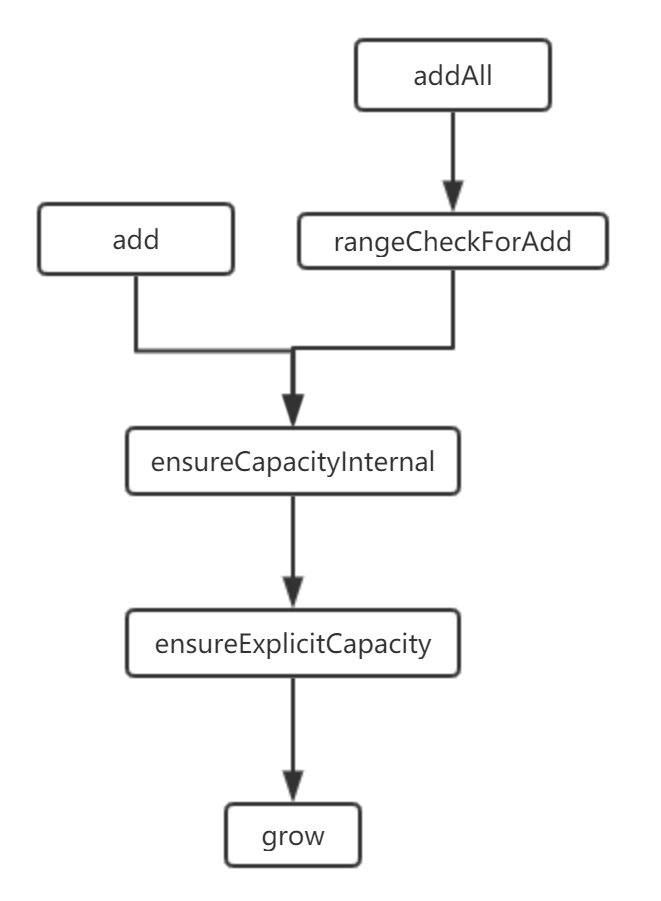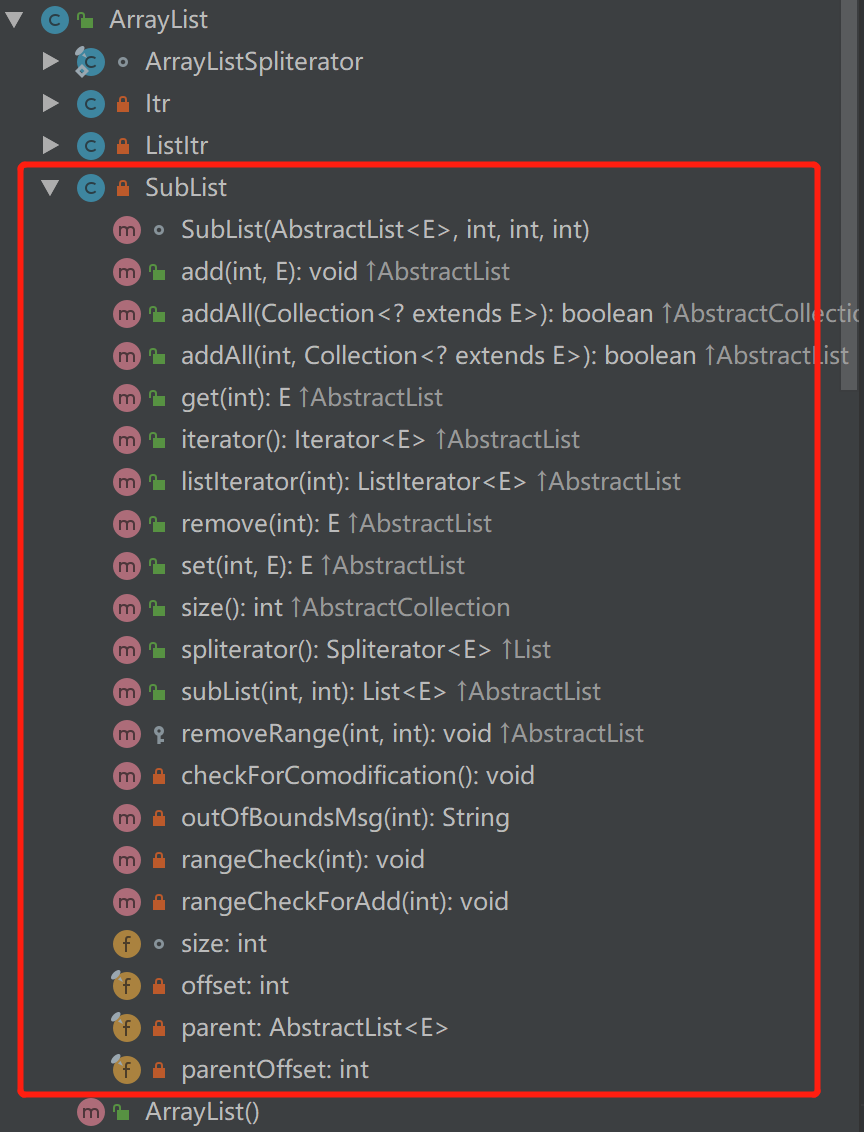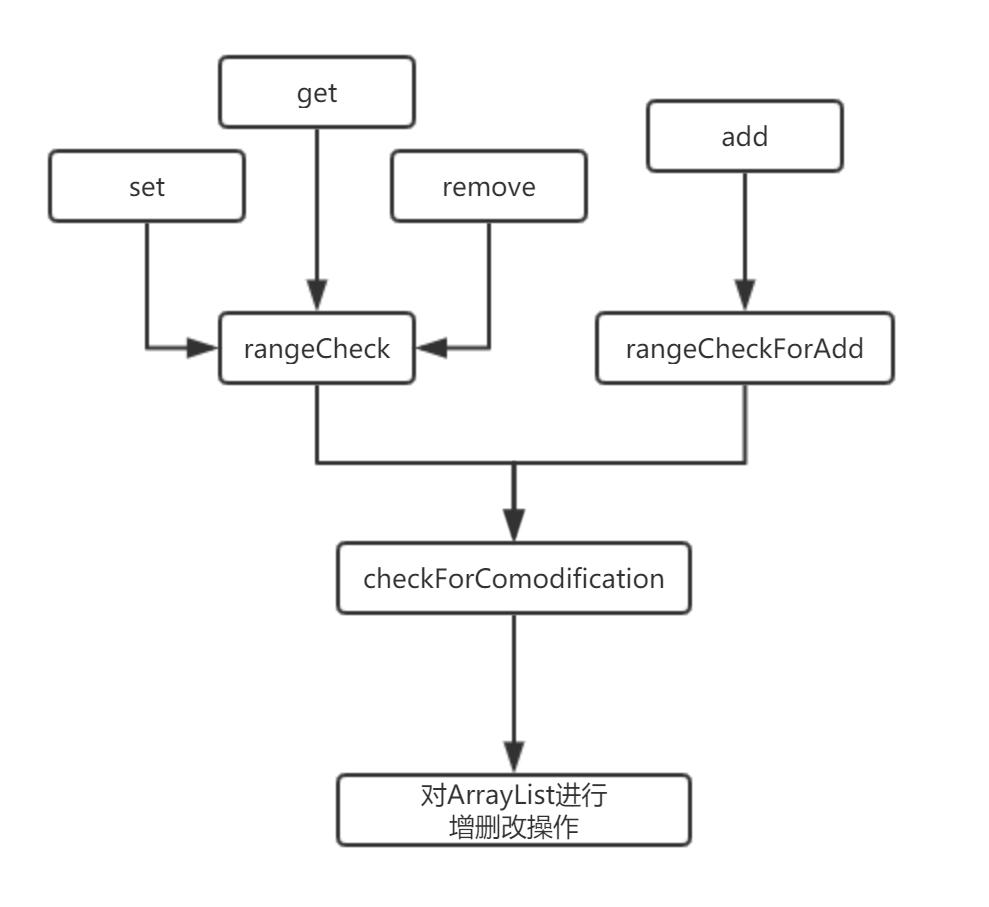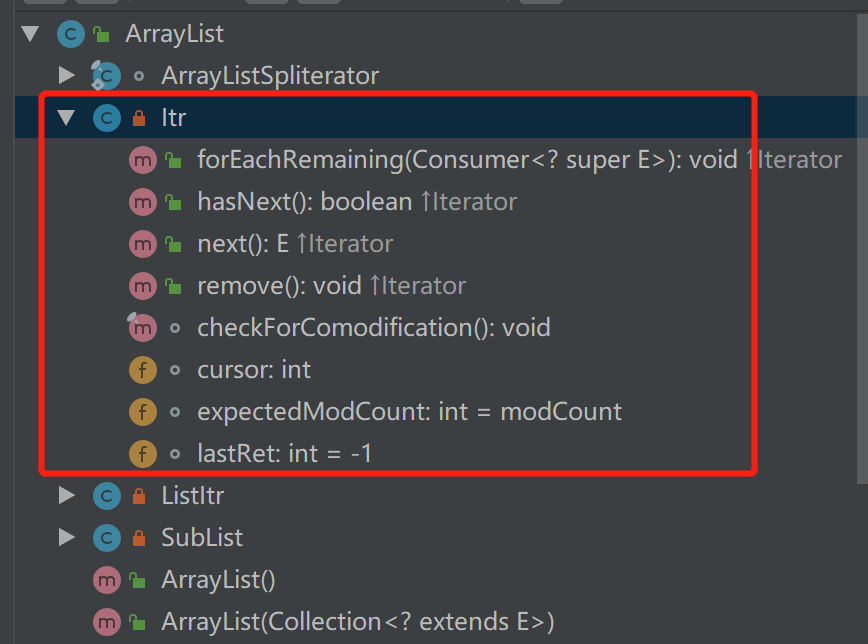ArrayList源码解析
ArrayList底层通过数组实现,是线程不安全的,具有随机访问快(根据下标),随机增删慢的特点
2. 成员变量
/**
* 默认初始容量
*/
private static final int DEFAULT_CAPACITY = 10;
/**
* 用于空对象的共享空数组
* 用于创建指定长度为0的ArrayList的构造方法
* java.util.ArrayList#ArrayList(int)
* java.util.ArrayList#ArrayList(java.util.Collection)
*
*/
private static final Object[] EMPTY_ELEMENTDATA = {};
/**
* 用于默认大小的空对象的共享空数组(跟上面的区分开来)
* 用于创建默认长度为10的ArrayList的构造方法
* java.util.ArrayList#ArrayList()
*
*/
private static final Object[] DEFAULTCAPACITY_EMPTY_ELEMENTDATA = {};
/**
* 存储内容的数组
*/
transient Object[] elementData; // non-private to simplify nested class access
/**
* ArrayList的长度
*/
private int size;
/**
* 数组的最大长度
*/
private static final int MAX_ARRAY_SIZE = Integer.MAX_VALUE - 8;
复制代码
这里有一点要特别注意: elementData.length 是指数组的长度 size 是指List的长度 这两个长度不是一样的
3. 构造函数
public ArrayList(int initialCapacity) {
if (initialCapacity > 0) {
// 初始容量大于0时,新建Object数组指向elementData
this.elementData = new Object[initialCapacity];
} else if (initialCapacity == 0) {
// 初始容量等于0时,EMPTY_ELEMENTDATA数组指向elementData
this.elementData = EMPTY_ELEMENTDATA;
} else {
// 初始容量小于0,抛出异常
throw new IllegalArgumentException("Illegal Capacity: "+
initialCapacity);
}
}
public ArrayList() {
// 无参构造,elementData指向默认的空数组
// 这也表明,elementData == DEFAULTCAPACITY_EMPTY_ELEMENTDATA的话
// 表示ArrayList还没有添加过任何元素
this.elementData = DEFAULTCAPACITY_EMPTY_ELEMENTDATA;
}
public ArrayList(Collection<? extends E> c) {
// collection转数组
elementData = c.toArray();
if ((size = elementData.length) != 0) {
// 数组长度不等于0
// [2] c.toArray might (incorrectly) not return Object[] (see 6260652)
if (elementData.getClass() != Object[].class)
// [1]
elementData = Arrays.copyOf(elementData, size, Object[].class);
} else {
// replace with empty array.
this.elementData = EMPTY_ELEMENTDATA;
}
}
复制代码
[1] 处ArrayList的源码中,涉及到数组复制的,都是使用Arrays提供的工具类
[2] 处关于toArray方法不一定返回Object数组,可以看看这篇文章 c.toArray might not return Object[]?
如果是涉及到数组的移动(有添加、删除引发),会使用 java.lang.System#arraycopy 方法
4. 常用的方法
4.1 添加
方法执行流程

可以看到 add 和 addAll 方法都会使用到 ensureCapacityInternal ,该方法中的核心代码是对 ensureExplicitCapacity 方法的调用
ensureExplicitCapacity 有两点作用:
modCount grow
modCount 记录了对象被修改的次数
java.util.ArrayList#add(E)
public boolean add(E e) {
/*
1. 确保elementData数组拥有足够的容量
2. 增加修改次数
*/
ensureCapacityInternal(size + 1); // Increments modCount!!
// 数组添加元素
elementData[size++] = e;
return true;
}
/**
* 确保数组拥有足够的容量
* @param minCapacity 最小需要的容量
*/
private void ensureCapacityInternal(int minCapacity) {
if (elementData == DEFAULTCAPACITY_EMPTY_ELEMENTDATA) {
// 表示elementDat还没有添加过元素
minCapacity = Math.max(DEFAULT_CAPACITY, minCapacity);
}
ensureExplicitCapacity(minCapacity);
}
private void ensureExplicitCapacity(int minCapacity) {
// 增加修改次数
modCount++;
// overflow-conscious code
if (minCapacity - elementData.length > 0)
// 当最小需要的容量超出了数组的长度,则需要扩容
grow(minCapacity);
}
private void grow(int minCapacity) {
// overflow-conscious code
int oldCapacity = elementData.length;
// 扩容1.5倍
int newCapacity = oldCapacity + (oldCapacity >> 1);
// 扩容后还是小于需要的最小容量,则使用minCapacity作为newCapacity
if (newCapacity - minCapacity < 0)
newCapacity = minCapacity;
// 扩容后发现newCapacity大于最大的数组长度
if (newCapacity - MAX_ARRAY_SIZE > 0)
newCapacity = hugeCapacity(minCapacity);
// 通过Arrays工具类进行数组扩容
// minCapacity is usually close to size, so this is a win:
elementData = Arrays.copyOf(elementData, newCapacity);
}
复制代码
java.util.ArrayList#add(int, E)
public void add(int index, E element) {
// 检查index有没有越界
rangeCheckForAdd(index);
ensureCapacityInternal(size + 1); // Increments modCount!!
// 将elementData[index:]的元素移动到elementData[index+1:]
System.arraycopy(elementData, index, elementData, index + 1,
size - index);
// 在index位置添加元素
elementData[index] = element;
size++;
}
private void rangeCheckForAdd(int index) {
// [1]
if (index > size || index < 0)
throw new IndexOutOfBoundsException(outOfBoundsMsg(index));
}
复制代码
- [1]处判断是否越界不是根据
elementData的长度,而是根据ArrayList的长度size去判断
java.util.ArrayList#addAll(java.util.Collection<? extends E>)
public boolean addAll(Collection<? extends E> c) {
Object[] a = c.toArray();
int numNew = a.length;
ensureCapacityInternal(size + numNew); // Increments modCount
System.arraycopy(a, 0, elementData, size, numNew);
size += numNew;
return numNew != 0;
}
复制代码
方法很简单,自己look look就行了
4.2 删除
java.util.ArrayList#remove(int)
public E remove(int index) {
// 检查是否越界
rangeCheck(index);
modCount++;
// 根据index找到对应的value
E oldValue = elementData(index);
int numMoved = size - index - 1;
if (numMoved > 0)
// 将elementData[index+1:]移动到elementData[index:]
System.arraycopy(elementData, index+1, elementData, index, numMoved);
// 清空最后一个元素
elementData[--size] = null; // clear to let GC do its work
return oldValue;
}
private void rangeCheck(int index) {
if (index >= size)
throw new IndexOutOfBoundsException(outOfBoundsMsg(index));
}
E elementData(int index) {
return (E) elementData[index];
}
复制代码
java.util.ArrayList#remove(java.lang.Object)
public boolean remove(Object o) {
if (o == null) {
// 如果o为null对象
for (int index = 0; index < size; index++)
// 正序遍历,将第一个null对象移除
if (elementData[index] == null) {
fastRemove(index);
return true;
}
} else {
for (int index = 0; index < size; index++)
if (o.equals(elementData[index])) {
fastRemove(index);
return true;
}
}
return false;
}
private void fastRemove(int index) {
modCount++;
int numMoved = size - index - 1;
if (numMoved > 0)
System.arraycopy(elementData, index+1, elementData, index,
numMoved);
elementData[--size] = null; // clear to let GC do its work
}
复制代码
其他删除的方法的实现都不负责,有兴趣可以自己挑来看看
这里可以看到,很多方法里面,关于数据的移动,都是通过 System.arraycopy 实现
4.3 查找
public E get(int index) {
// 检查数组越界
rangeCheck(index);
return elementData(index);
}
复制代码
方法很简单,自己look look
5. 内部类
SubList
ArrayList有个 subList 的方法,这个方法返回的是ArrayList的一个视图
public List<E> subList(int fromIndex, int toIndex) {
subListRangeCheck(fromIndex, toIndex, size);
return new SubList(this, 0, fromIndex, toIndex);
}
复制代码
方法返回的是SubList类的对象

可以看到这个类把ArrayList的增删改查方法基本都自己实现了一遍
先来看看构造方法
SubList(AbstractList<E> parent,
int offset, int fromIndex, int toIndex) {
this.parent = parent;
this.parentOffset = fromIndex;
this.offset = offset + fromIndex;
this.size = toIndex - fromIndex;
// [1]
this.modCount = ArrayList.this.modCount;
}
复制代码
可以看到[1]处,在创建SubList对象的时候,会把当时ArrayList.modCount的值赋值给SubList.modCount,Sublist的modCount的用处体现在 checkForComodification 方法中(下文会提及)
再来看看增删改查的流程

可以看到增删改查的方法都会先调用检查边界的方法 rangeCheck 、 rangeCheckForAdd ,然后调用 checkForComodification
checkForComodification 方法的作用是检查SubList对象的modCount跟当前ArrayList的modCount是否相等
private void rangeCheck(int index) {
if (index < 0 || index >= this.size)
throw new IndexOutOfBoundsException(outOfBoundsMsg(index));
}
private void rangeCheckForAdd(int index) {
if (index < 0 || index > this.size)
throw new IndexOutOfBoundsException(outOfBoundsMsg(index));
}
private void checkForComodification() {
// [1]
if (ArrayList.this.modCount != this.modCount)
throw new ConcurrentModificationException();
}
复制代码
可以看到[1]处,当检查modCount不相等的时候,表示这时还有其他对象在修改ArrayList,就会抛出 ConcurrentModificationException
modCount 在 Itr 内部类中也起着相同的作用
现在来看看SubList增删改查的具体是现实
public void add(int index, E e) {
rangeCheckForAdd(index);
checkForComodification();
// 实际调用的是ArrayList的add方法
parent.add(parentOffset + index, e);
// 同步一下modCount的信息
this.modCount = parent.modCount;
this.size++;
}
public E remove(int index) {
rangeCheck(index);
checkForComodification();
// 实际调用的是ArrayList的remove方法
E result = parent.remove(parentOffset + index);
// 同步一下modCount
this.modCount = parent.modCount;
this.size--;
return result;
}
public E set(int index, E e) {
rangeCheck(index);
checkForComodification();
// 调用ArrayList的elementData方法
E oldValue = ArrayList.this.elementData(offset + index);
ArrayList.this.elementData[offset + index] = e;
return oldValue;
}
public E get(int index) {
rangeCheck(index);
checkForComodification();
// 调用ArrayList的elementData方法
return ArrayList.this.elementData(offset + index);
}
复制代码
正如上面所提及的,SubList对增删改查的实现就是 检查边界 + 比较modCount + 调用ArrayList本身对应的方法
Itr
在ArrayList中会有 iterator 方法,方法具体实现如下
public Iterator<E> iterator() {
return new Itr();
}
复制代码
可以看到方法是直接返回一个新建的Iter类对象

Itr内部类实现了Iterator接口,来看看它的成员变量
int cursor; // 下一个元素的下标
int lastRet = -1; // 最后一次返回的元素的下标; -1 if no such
int expectedModCount = modCount; // [1]期望的修改次数
复制代码
可以从[1]处看到,Itr对象也会使用modCount,实际作用也是检查当前有没有别的对象在修改ArrayList,如果有就抛 ConcurrentModificationException 异常
接下来看看常用方法的实现
public boolean hasNext() {
return cursor != size;
}
public E next() {
// 检查modCount
checkForComodification();
int i = cursor;
// 检查有没有超出size
if (i >= size)
throw new NoSuchElementException();
Object[] elementData = ArrayList.this.elementData;
// 检查有没有超出数组长度
if (i >= elementData.length)
throw new ConcurrentModificationException();
cursor = i + 1;
return (E) elementData[lastRet = i];
}
public void remove() {
if (lastRet < 0)
throw new IllegalStateException();
checkForComodification();
try {
ArrayList.this.remove(lastRet);
cursor = lastRet;
lastRet = -1;
expectedModCount = modCount;
} catch (IndexOutOfBoundsException ex) {
throw new ConcurrentModificationException();
}
}
final void checkForComodification() {
if (modCount != expectedModCount)
throw new ConcurrentModificationException();
}
复制代码
方法还是比较容易读懂的,可以自己看看











![[HBLOG]公众号](https://www.liuhaihua.cn/img/qrcode_gzh.jpg)

